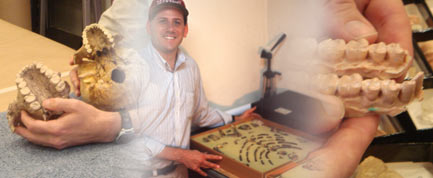Teeth Offer Clues to Human Diet Evolution

This Behind the Scenes article was provided to LiveScience in partnership with the National Science Foundation.
University of Arkansas anthropology professor Peter Ungar has developed many talents during his distinguished career, spending hours crouched in forests in remote parts of the world studying monkeys, using dental techniques to create molds of teeth, and finding new ways to use modern-day technology to study the wear and tear on those teeth. Through all of these efforts, he is looking for clues as to what modern-day primates eat — and what that tells us about what our ancient human ancestors actually ate. Most recently, Ungar and his colleagues, Frederick E. Grine of State University of New York at Stony Brook and Mark F. Teaford of Johns Hopkins University in Baltimore, Md., reported findings on an early human cousin that suggest form and structure of teeth alone are not enough to predict the diet of ancient humans. "Teeth are perfect for testing diet hypotheses, because they are the best preserved items in the fossil record and are part of the digestive system," Ungar said. "But until now, we haven’t had the technology to pull much information out of them." Until recently, scientists counted the pits and scratches on teeth by looking at images from high-resolution electron microscopes. But such counts depended upon the expertise of the observer and often proved difficult to reproduce. "The problem then is that you have to count and measure those features by hand, which introduces a high likelihood of human error. That's a very subjective process, and you're going to get variability between the measurements of any two researchers," Ungar said. "We needed an objective, automated, repeatable way to quantify wear on teeth." Ungar developed a way of using Geographic Information System software to create a different kind of map, using the software for dental topography, to show the mountains and valleys formed by the wear patterns on teeth. Just as GIS can be used to measure topographical features on a landscape, such as slope, elevation and aspect, Ungar found it could analyze dental features that are important to chewing and processing foods. Specifically, the researchers used GIS to calculate slope and angularity values for each tooth; slope refers to the steepness of a tooth cusp, whereas angularity is a measure of overall jaggedness. In 2003, Ungar was able to increase the resolution of his measurements by using a white light scanning confocal microscope. The length, width and even depth information about specific features is automatically and objectively recorded by the instrument. The detailed, three-dimensional information allows researchers to determine characteristics of the surface, such as roughness and directionality of the wear using fractal analyses borrowed from mechanical engineering. Ungar combines his high-tech work with old-fashioned anthropology field work. Working with colleagues, he has logged thousands of hours in forests in Central and South America as well as Indonesia observing the diets of different apes and monkeys. The researchers tranquilize the animals and use the same dental techniques employed by dentists to make crowns to create high-resolution molds of primate teeth using epoxy. Ungar also has created dental impressions of some of the world’s most famous fossil ancestors, including AL-288-1, better known as "Lucy," and OH-5, the "Nutcracker Man." This work has resulted in a repository of hundreds of tooth impressions. Using this library of teeth, he can compare what modern-day primates eat and the wear patterns on their teeth to the wear patterns on fossil teeth to get direct evidence of what types of foods they were eating. His work has found anatomical evidence to support some longstanding hypotheses — and in other cases has found evidence that suggests the current models are wrong. "The models are fine in and of themselves, but we need to go further," Ungar said. "We need to test the hypotheses." With his pioneering techniques, he has found a way to do just that.
- Video: Lucy's Tendon-cies
- Tough Early Humans Loved Fruit
- Top 10 Missing Links
Editor's Note: This research was supported by the National Science Foundation (NSF), the federal agency charged with funding basic research and education across all fields of science and engineering. See the Behind the Scenes Archive.
Sign up for the Live Science daily newsletter now
Get the world’s most fascinating discoveries delivered straight to your inbox.









